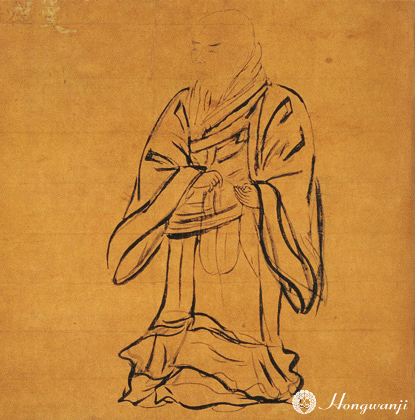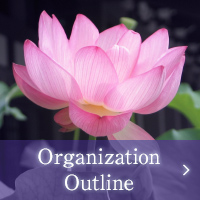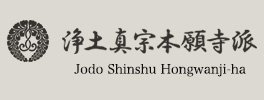Teachings
Shinran Shonin

Shinran Shonin (1173-1263) was born at the close of the Heian period, when political power was passing from the imperial court into the hands of warrior clans. It was during this era when the old order was crumbling, however, that Japanese Buddhism, which had been declining into formalism for several centuries, underwent intense renewal, giving birth to new paths to enlightenment and spreading to every level of society.
Shinran was born into the aristocratic Hino family, a branch of the Fujiwara clan, and his father, Arinori, at one time served at court. At the age of nine, however, Shinran took the tonsure under the guidance of a Tendai monk, Jien and began studying at the Tendai temple on Mt. Hiei, where he spent twenty years in monastic life. From the familiarity with Buddhist writings apparent in his later works, it is clear that he exerted great effort in his studies during this period. He probably also performed such practices as continuous recitation of the nembutsu for prolonged periods.
Conversion
After twenty years, however, he despaired of ever attaining awakening through such discipline and study. He was also discouraged by the deep corruption that pervaded the mountain monastery. Years earlier, Honen Shonin (1133-1212) had descended Mt. Hiei and begun teaching a radically new understanding of religious practice, declaring that all self-generated efforts toward enlightenment were tainted by attachments and therefore meaningless. Instead of such practice, one should simply say the nembutsu, not as a contemplative exercise or means of gaining merit, but by way of wholly entrusting oneself to Amida's Vow to bring all beings to enlightenment.
When he was twenty-nine, Shinran undertook nightly retreats at Rokkakudo temple in Kyoto to determine his future course. At dawn on the ninety-fifth day, Prince Shotoku appeared to him in a dream. Shinran took this as a sign that he should seek out Honen, and went to hear his teaching daily for a hundred days. He then abandoned his former Tendai practices and joined Honen's movement. In the Tannisho, which is a record of Shinran's words and deeds, it states that he once said that even if he were to be deceived by Master Honen and fell into hell saying the nembutsu, he would have no regrets.
Exile
At this time, however, the established temples were growing jealous of Honen, and in 1207 they succeeded in gaining a government ban on his nembutsu teaching. Several followers were executed, and Honen and others, including Shinran, were banished from the capital.
Shinran was stripped of his priesthood, given a layman's name, and exiled to Echigo (Niigata prefecture) on the Japan Sea coast. Resisting that imperial decree, Shinran did not take that given layman's title but named himself as Toku (lit., "stubble headed"), declaring himself "neither monk nor layman."
About this time, he married Eshinni and began raising a family. He was pardoned after five years, but decided not to return to Kyoto. Instead, in 1214, at the age of forty-two, he made his way into the Kanto region, where he spread the nembutsu teaching for twenty years, building a large movement among the peasants and lower samurai.
Return to Kyoto
Shinran in his sixties, began a new life, with his return to Kyoto devoting his final three decades to writing. He did not give sermons or teach disciples, but lived with relatives, supported by gifts from his followers in the Kanto area. After his wife returned to Echigo to oversee property there, he was tended by his youngest daughter, Kakushinni.
It is from this period that most of his writings stem. He completed his major work, popularly known as Kyogyoshinsho (The True Teaching, Practice and Realization of the Pure Land Way), and composed hundreds of hymns in which he rendered the Chinese scriptures accessible to ordinary people. At this time, problems in understanding the teaching arose among his followers in the Kanto area, and he wrote numerous letters and commentaries seeking to resolve them.
There were people who asserted that one should strive to say the nembutsu as often as possible, and others who insisted that true entrusting was manifested in saying the nembutsu only once, leaving all else to Amida. Shinran rejected both sides as human contrivance based on attachment to the nembutsu as one's own good act. Since genuine nembutsu arises from true entrusting that is Amida's working in a person, the number of times it is said is irrelevant.
Further, there were some who claimed that since Amida's Vow was intended to save people incapable of good, one should feel free to commit evil. For Shinran, however, emancipation meant freedom not to do whatever one wished, but freedom from bondage to the claims of egocentric desires and emotions. He therefore wrote that with deep trust in Amida's Vow, one came to genuine awareness of one's own limitations.
Near the end of his life, Shinran was forced to disown his eldest son Zenran, who caused disruptions among the Kanto following by claiming to have received a secret teaching from Shinran. Nevertheless, his creative energy continued to his death at ninety, and his works manifest an increasingly rich, mature, and articulate vision of human existence that reveals him to be one of Japan's most profound and original religious thinkers.




